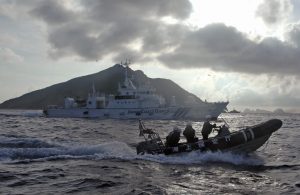China has escalated its pressure campaign against Japan’s Senkaku Islands in the East China Sea in recent months, using increased maritime and air operations and heightened administrative and enforcement claims. Beijing claims the islands, which Japan administers, as the Diaoyu Islands.
Earlier this month Chinese coast guard vessels loitered in the territorial waters around the Senkaku Islands for nearly 40 hours, the longest such incursion since Japan nationalized the islands in 2012.
Chinese government vessels have maintained a constant presence in the waters around the islands for more than two months.
The persistence of the Chinese ships near the islands has required Japan to maintain near-constant maritime and aerial surveillance of the area to track their movements, such as the incursion into the island’s territorial waters. The surveillance demands have raised concerns about Japan’s capacity to maintain the pace of operations required to monitor Chinese movements in the area.
At the same time, China has increased its already substantial aerial pressure against Japan’s Air Self Defense Force over the islands. In addition to the patrol and surveillance missions that Japan flies to monitor China’s maritime activity, it is being challenged increasingly by Chinese fighter jets approaching Japan’s airspace over the islands.
According to the Japanese government, China is now using planes from a different, closer air base to send jets over Japanese territory in the Ryukyus. The reduced time required for the Chinese planes to reach the Senkakus is pressuring Japan’s jets, which now have a longer flight time to reach the same airspace than the Chinese jets they are trying to intercept, forcing them to respond immediately to any flights from the Chinese base in case they turn toward the islands. Japan is also now sending four planes to intercept each Chinese fighter instead of two, to ensure the Chinese jets turn away from the islands.
The summer has also seen an escalation of administrative tit-for-tat over the islands between the Japanese and Chinese governments.
In June the Japanese town that the islands are a part of renamed the islands to clarify administrative confusion. The Chinese government strongly objected to the move, believing the status change reasserted Japan’s sovereignty over the islands. A Chinese Foreign Ministry spokesman called the islands “China’s inherent territory” and criticized the re-naming as a “serious provocation,” adding that China was “resolute in safeguarding our territorial sovereignty”
Just days after the naming dispute, China responded with a renaming of its own: re-designating 50 seabed areas in the East China Sea, including areas the Senkaku Islands are a part of. More recently, China warned the Japanese government that Japanese vessels in the waters around the Senkaku Islands are “trespassing” in Chinese waters. While the complaints appear to be mainly diplomatic, it raises the specter of Chinese coast guard vessels attempting to enforce China’s claims against Japanese fishing vessels.
Japan has administered the islands since 1972 following the dissolution of the U.S. military governorship of the Ryukyu islands established after World War II. China has maintained a historic claim over the islands but maritime and aerial standoffs over Japan’s administration intensified after 2012 when the Japanese government purchased the islands from their private owner. In 2017, the United States publicly affirmed that its treaty obligations for the security of Japanese territory included any moves against the Senkaku Islands, clearing up several years of diplomatic ambiguity.

































